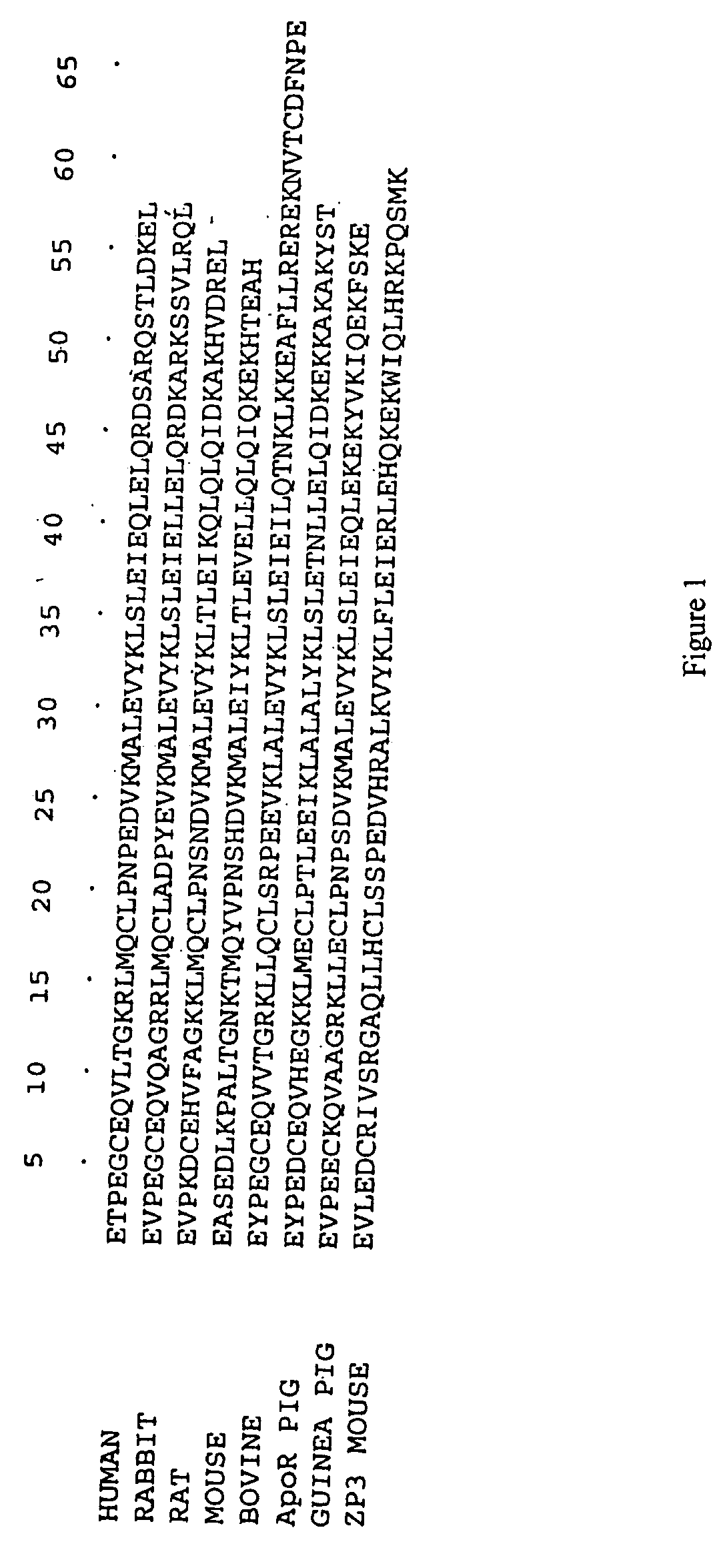Production of multimeric fusion proteins using a c4bp scaffold
a multimeric fusion protein and scaffold technology, applied in the direction of peptides, drug compositions, immunological disorders, etc., can solve the problems of cumbersome technique, short half-life, and reduced usefulness
- Summary
- Abstract
- Description
- Claims
- Application Information
AI Technical Summary
Benefits of technology
Problems solved by technology
Method used
Image
Examples
example 1
Production of db-C4bp
Vector Construct.
[0144] An expression vector encoding the downstream box peptide sequence MASMNHKGS (Sprengert M. L., Fuchs E. and Porter A. G 1996 “The downstream box: an efficient and independent translation initiation signal in Escherichia coli.” EMBO J. Volume 15, 665-674) fused N-terminal to the 57 amino acid “core” domain of the human C4bp alpha chain was constructed.
[0145] Briefly, the C4bp core domain is encoded entirely within a single exon in the human genome, thus allowing it to be amplified directly from human genomic DNA. The oligo-nucleotide primers used were: [0146] AVD102: 5′ CCCGCGGATCCGAGACCCCCGAAGGCTGTGA3′; and [0147] AVD103: 5′ CCCCGGAATTCTTATTATAGTTCTTTATCCAAAGTGG3′.
[0148] These contained added restriction sites which were used for cloning the amplified DNA fragment. The 183 base-pair fragment obtained on digesting the PCR product with the enzymes BamHI and EcoRI was cloned downstream of the translational enhancer or “downstream box” an...
example 2
Purification of db-C4bp with a Heating Step
[0160] The solution containing the other 30 ml aliquot of db-C4bp was heated at 76° C. for 15 minutes and then centrifuged at 20,500 rpm for 1 hour. The supernatant, containing db-C4bp, was purified by ion-exchange chromatography (DEAE Fast Flow 70 mls), using Tris buffer (5OmM pH7) and a salt gradient (0M-1M NaCl). Fractions of 7.5 ml were collected. The fusion protein eluted between 300-400 mM NaCl (FIG. 5).
[0161] Fractions B8 to B11 were pooled and the final solution was then concentrated to a volume of 10 mls before being chromatographed on a gel filtration column (S-75 26 / 60). Fractions of 5 ml were collected. The fusion protein was eluted from this column with a volume of 140 mls buffer (FIG. 6). The calibration of the column with molecular weight standards implies a molecular weight identical to that of the protein purified without heating (see above), whereas the expected molecular weight of the monomer is 7.491 kDa. This fusion p...
example 3
Treatment of Protein with Denaturant
[0166] To confirm further that the protein was indeed oligomeric, an attempt was made to denature purified protein in 6M guanadinium chloride and 20 mM DTT (dithiothreitol) at room temperature before repeating gel filtration under denaturing conditions.
[0167] Briefly, a culture of 500 mls of the cells of example 1 were grown and induced as described above. The fusion protein was purified by ion-exchange chromatography, using TrisHCl buffer (50 mM pH 7.4) and a salt gradient (0M-1M NaCl). The fusion protein eluted between 450-650 mM NaCl and was then concentrated to a volume of 10 mls. After this concentration step, the concentration of db-C4bp protein was 740 micrograms per ml.
[0168] The protein was then treated at a concentration of 740 micrograms per ml overnight at 4° C. with 6M guanidinium chloride and 20 mM DTT before being chromatographed on a gel filtration column (S-75). The fusion protein was eluted from this column with a volume of 11...
PUM
| Property | Measurement | Unit |
|---|---|---|
| concentration | aaaaa | aaaaa |
| weight | aaaaa | aaaaa |
| weight | aaaaa | aaaaa |
Abstract
Description
Claims
Application Information
 Login to View More
Login to View More - R&D
- Intellectual Property
- Life Sciences
- Materials
- Tech Scout
- Unparalleled Data Quality
- Higher Quality Content
- 60% Fewer Hallucinations
Browse by: Latest US Patents, China's latest patents, Technical Efficacy Thesaurus, Application Domain, Technology Topic, Popular Technical Reports.
© 2025 PatSnap. All rights reserved.Legal|Privacy policy|Modern Slavery Act Transparency Statement|Sitemap|About US| Contact US: help@patsnap.com



